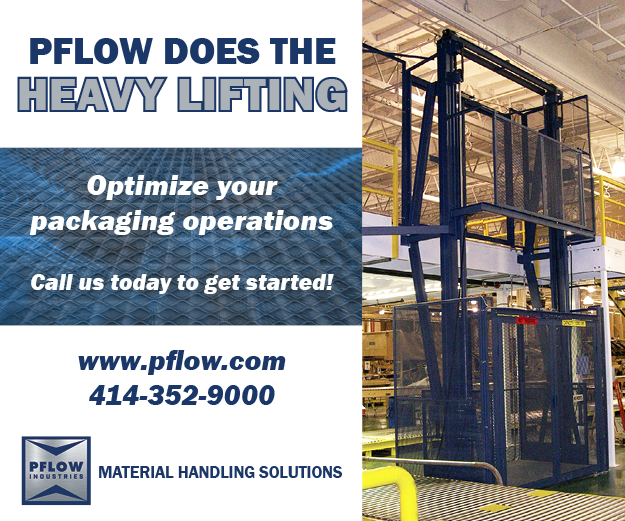Leaders of the (Gel) Pack
The Arctic Express Pack gel pack manufacturing system, featuring a KPS Global® freezer solution, reduces the production process from weeks to minutes while reducing the carbon footprint up to 97%
By James Costanza and Brian Bunnett,
 It may not exactly fit the true definition of an “a-ha moment,” but after years of working in the product-distribution business, it had begun to dawn on Brian Bunnett that there must be a better, more efficient, more cost-effective way to configure and operate a cold-chain supply system. Specifically, he had become more aware of the inefficiencies in many distribution systems as they related to the packaging, storage and transport of finished products that utilized gel packs in order to be kept frozen or at cooler temperatures as they made their way to the end user.
It may not exactly fit the true definition of an “a-ha moment,” but after years of working in the product-distribution business, it had begun to dawn on Brian Bunnett that there must be a better, more efficient, more cost-effective way to configure and operate a cold-chain supply system. Specifically, he had become more aware of the inefficiencies in many distribution systems as they related to the packaging, storage and transport of finished products that utilized gel packs in order to be kept frozen or at cooler temperatures as they made their way to the end user.
“I was at a facility one day and they were using gel packs in their packaging process. They had forklifts going back and forth retrieving packs from a giant 50,000-cubic-foot freezer. With long packing lines, the packs were thawing and I realized there had to be a better way to do this,” recalled Bunnett. “Our goal is to fully automate an area of the cold-chain industry that has never been automated before.”
What has grown out of this observation is Arctic Express Pack, LLC. Based in Fort Worth, TX, Arctic Express Pack has developed a patented gel pack manufacturing technology that is designed to streamline the labor-intensive process that is needed to manufacture, freeze, store and transport gel packs that are used to keep commodities such as food-and-beverage products and pharmaceuticals at a desired temperature during storage and shipping.
Gel packs are something that we are all familiar with, but to which we rarely give much thought. For an idea of just how important gel packs are, though, consider that online order of steaks that arrives at your house fully frozen; you have gel packs to thank for that. Or consider a life-saving medicine that must be kept at a strict temperature as it is transported to its final destination. These examples should give you a better understanding of the gel pack’s importance.
Surveying The Landscape
 With daily global shipments of perishable products numbering in the millions, gel packs play an indispensable role in ensuring that product quality is not compromised during the transport process. This is a critical consideration for products that must be kept at a pre-determined temperature, lest they spoil or become unstable.
With daily global shipments of perishable products numbering in the millions, gel packs play an indispensable role in ensuring that product quality is not compromised during the transport process. This is a critical consideration for products that must be kept at a pre-determined temperature, lest they spoil or become unstable.
While the importance of gel packs in these processes is clear, their traditional method of manufacture is a long and laborious one. The activities at a typical gel pack production facility can resemble a finely choreographed ballet, with long packing lines cranking out product and a fleet of forklifts crisscrossing the warehouse floor as they move pallets of gel packs to storage freezers as large as 100,000 cubic feet.
It is in these freezers where the liquid in the gel packs is cooled or frozen to a desired temperature – it is also where the first really noticeable inefficiencies and potential speed bumps in the gel pack production chain appear.
“If you take a pallet of gel packs to a freezer, with each pallet capable of holding up to 1,800 packs, it will take two-and-a-half weeks for them to freeze,” explained Bunnett. “Then after they are frozen, you take them from the freezer to a truck, to the user, to a large holding freezer before being retrieved and moved to the packaging line. By this time, with all of the handling and touch points along the way, some of the gel packs are bound to be more frozen than others.”
With some facilities requiring upwards of 5, 10, 15 or even up to 30 pallets a day – or 720,000 individual gel packs – the logistics required to keep an operation running smoothly, and delivering gel packs to the end user at the required temperature, can be daunting.
“Think about the logistics of an operation that requires 3 truckloads (72 pallets) a week,” said Bunnett. “You’re required to have multiple truckloads currently being frozen and multiple truckloads in route both to the freezer location and to the end user. Take this to the next step, all these pallets have to be unloaded from the trucks, placed into racks for freezing, reloaded back onto trucks, transported, unloaded again, placed back into storage racks located in a freezer and finally the gel packs are retrieved from storage and placed at pack out lines”
Packing It In
 While Bunnett knew there had to be a better, more effective way to manufacture gel packs, the next hurdle was identifying it. After nearly three years in development, the Arctic Express Pack gel pack manufacturing system promises to overcome or eliminate many of the inefficiencies in traditional gel pack production.
While Bunnett knew there had to be a better, more effective way to manufacture gel packs, the next hurdle was identifying it. After nearly three years in development, the Arctic Express Pack gel pack manufacturing system promises to overcome or eliminate many of the inefficiencies in traditional gel pack production.
Arctic Express Pack is a fully automated gel pack production system that can actually be installed at the end users packaging facility, which allows gel pack manufacture, freezing and storage to be done on-site and on-demand. This eliminates several time-consuming, inefficient, costly and environmentally insensitive transport and storage stages that have been baked-in components of traditional gel pack production in the past.
In order to make the Arctic Express Pack system work in eliminating the inefficiencies in traditional gel pack manufacturing, its fulcrum needs to be a freezer unit that can cool or freeze gel packs to a desired temperature in as little as 45 minutes. To find the right freezer solution for the operation, Arctic Express Pack collaborated with KPS Global, Inc., Fort Worth, TX. Formed in 2015, KPS Global is a leader in the design, manufacture, and installation of cold-storage solutions.
“For the freezer, we needed a solution where the temperature could be defined by the user,” said Costanza. “For example, some pharmaceutical companies may not want gel packs that are completely frozen because they could compromise the quality of the products that they are manufacturing and shipping.” With the systems today, Brian noted “they get frozen gel packs and then sweat them to try to get them to the proper temperature, but that takes a lot of guesswork and manual observation and intervention.”
The KPS Global freezer unit – which is a custom-designed and engineered cold-storage solution – fits seamlessly in the any warehouse setting. The KPS Global engineering team working closely with other equipment manufacturers to develop the perfect solution to meet all the demands.
 “Overall, KPS Global’s knowledge regarding the size of the compressor and condenser needed, their knowledge of how air circulates, how fast different things will freeze at different temperatures; they know all of these things,” said Bunnett. “Being able to work with their engineering team to figure things out, which was difficult to do, was really important.”
“Overall, KPS Global’s knowledge regarding the size of the compressor and condenser needed, their knowledge of how air circulates, how fast different things will freeze at different temperatures; they know all of these things,” said Bunnett. “Being able to work with their engineering team to figure things out, which was difficult to do, was really important.”
The KPS Global design team determined that the basic freezer unit that is part of the Arctic Express Pack system didn’t need to be massive in size in order to product a user’s typically supply of gel packs. In fact, the unit could be as small as 12 feet tall by 6 feet wide and 6 feet deep, which is much smaller than the 100,000-square-foot behemoths that populate many gel pack manufacturing facilities. The second critical part of the system is a vertical spiral conveyor that is positioned inside the freezer. For this component, Arctic Express Pack turned to an Israeli company, the NGB Group, which is located in Tsur Igal, Israel.
“The conveyor needed to be able to be scaled up or down in height so enough room could be created to go from producing, for example, 500 gel packs in one run to 1,000 in another,” said Bunnett. “A lot of people make conveyors, but we needed to find one that could work with exactly what KPS Global needed for its freezer and NGB Group was able to deliver that.”
Let’s Make Some Gel Packs
The final Arctic Express Pack gel pack manufacturing system amazes in both its simplicity and its ability to meet the needs of gel-pack users in an on-demand fashion.
The Arctic Express Pack process includes:
- A box of chain-linked bags filled with a freezing compound is placed at the head of the freezer
- The bags are fed through a unit that fills them with water; once filled, they are sealed
- The bags proceed through a specially designed slot that neither allows warm air to enter or cold air to exit the freezer
- Inside the freezer, the bags circle up a spiral conveyor
- After needing as little as 45 minutes to reach their desired temperature – the KPS Global freezer unit can achieve temperatures as low as -36ºF (-38ºC) – the bags slide down a chute and exit the freezer through another airtight slot
- The gel packs are then ready to be dispensed for use through a variety of methods
Though the entire Arctic Express Pack manufacturing process has been engineered to be completely automated, it can easily accommodate human intervention at the front and back ends. The technology has also been configured so that it can communicate wirelessly with the end user’s warehouse management system (WMS), which allows bar codes to be scanned and gel packs to be dispensed directly into a shipping box, with or without a human packer present.
“This is a custom-engineered solution that can be constructed to fit the individual needs of the user,” said Bunnett. “This first model perfectly illustrates how we can meet the customer’s needs, and it also shows how it can be modified over time as those needs change.”
In these days of increased focus on company’s being good corporate citizens, the Arctic Express Pack system also delivers verifiable environmental benefits. Arctic Express Pack recently performed a cost-analysis comparison between its system and a traditional gel pack manufacturer. The results found that a facility that uses 24,000 gel packs a week will save more than $100,000 annually in ancillary costs by converting to the Arctic Express Pack system.
Among the traditional ancillary costs that will be totally eliminated are daily deliveries from a third-party freezing site ($36,400), loading of cases into a storage freezer ($5,824), return of unused gel packs to a storage freezer ($6,500) and third-party freezer costs ($51,480). Additionally, the amount of corrugated waste that will be produced annually will decline from 52,000 boxes to 70 boxes. This also equates to a carbon-footprint reduction, as measured in kilograms of CO2 equivalent for transportation, freezer, forklift and cardboard waste activities, of 96% during the production of 24,000 16-ounce gel packs, and 97% for a 24,000-unit pallet of 48-ounce gel packs.
Conclusion
The new Arctic Express Pack technology is a definitive improvement over existing gel-pack production techniques, and by engineering, manufacturing and supplying the cutting-edge freezer units that are the foundation of the system, KPS Global, Inc., is playing a leading role in this revolutionary improvement in cold-chain efficiency, effectiveness and environmental sensitivity.
“KPS Global simply makes the best freezer for our needs, one that can be set at any temperature,” said Bunnett. “We look forward to working with them as we move forward in the production and use of the Arctic Express Pack system.”
About the Authors:
James Costanza is a Technical Fellow for KPS Global®, Inc., Fort Worth, TX, USA, and can be reached at james.costanza@kpsglobal.com. Formed in 2015 after a series of strategic acquisitions by the D Cubed (D3) Group private-equity firm, KPS Global designs, manufactures and installs insulated panel solutions across multiple industries, including grocery store, convenience store, big box retail, warehouse and scientific, and has manufacturing operations in Fort Worth, TX; Goodyear, AZ; Piney Flats, NC; San Dimas, CA; and Conyers, GA. For more information on KPS Global and its many walk-in cooler and freezer solutions, panel systems, manufactured doors and other cold-storage-unit components, please visit kpsglobal.com
Brian Bunnett co-founded Arctic Express Pack (AEP) in 2018 and can be reached at Brian.b@arcticexpresspack.com. For the last 30 years Bunnett has been involved with bringing solutions from conceptual ideas to market place. He co-founded Streamline Packaging Solutions in 1999, which specializes in a solutions-based processes and packaging distribution. Bunnett helped design new foam-in-place technology for Polyair and a table top cartridgeless foam-in-place system for Polynest. Bunnett, Cofounder of Airguard Packaging Solutions, a company purposed in the design and marketing of cutting edge air cushion technology. In 2017, Bunnett cofounded Oero, an industrial packaging think tank with the goal of bringing new innovative ideas and concepts to fruition. Bunnett is currently the President of Streamline Packaging Solutions, President of Arctic Express Pack and President of Oero LLC. All three are missioned to bring new and innovative ideas to a market in search of solutions to reduce labor, freight, space while improving our environmental. Over the last 30 years Bunnett has amassed dozens of patents all centered around the mission of the companies he co-founded. For more information on Artic Express Pack and how they are fulfilling the needs of the cold chain industry to automate the gel pack industry, please visit https://arcticexpresspack.com/






